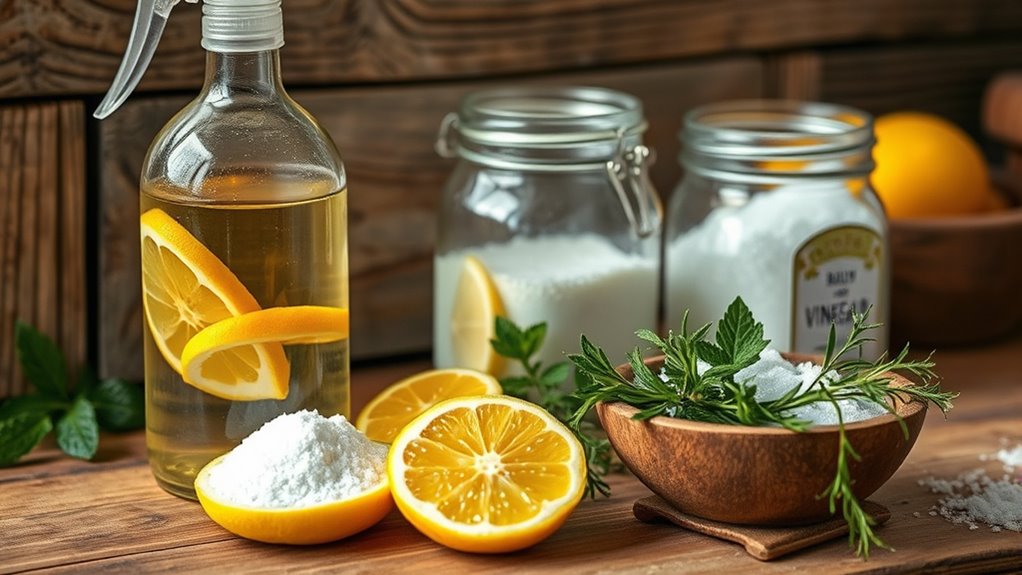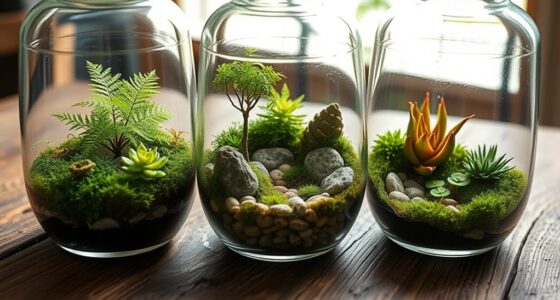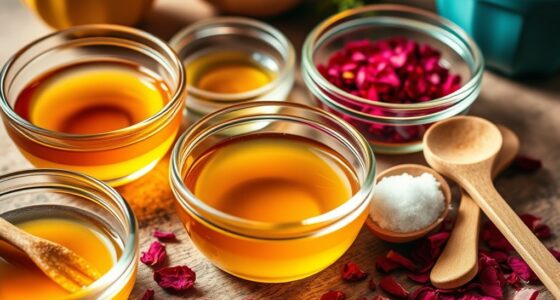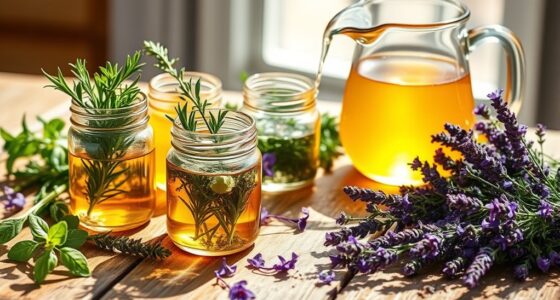To create DIY organic household cleaners, gather simple ingredients like vinegar, baking soda, lemon juice, and essential oils such as tea tree or citrus. You can make versatile solutions like all-purpose citrus spray, vinegar-based glass cleaner, or baking soda scrubs for tough stains. These natural options are safe for your home and family. Keep your supplies organized and stored properly to guarantee safety. Keep exploring to discover easy recipes and tips for a healthier, eco-friendly cleaning routine.
Key Takeaways
- Utilize natural ingredients like vinegar, baking soda, lemon juice, and essential oils to create safe, effective household cleaners.
- Prepare versatile recipes such as citrus all-purpose cleaner, vinegar glass cleaner, and baking soda scrub for various surfaces.
- Store homemade cleaners in labeled, child-proof containers made of glass or durable plastic, kept in cool, dry areas.
- Make eco-friendly floor and toilet cleaners using simple mixes of vinegar, baking soda, essential oils, and castile soap.
- Enhance cleaning routines with natural room sprays using essential oils for fresh, chemical-free air and fabric freshness.
Ingredients You Need for Natural Cleaners

To create effective DIY organic household cleaners, you need just a few simple ingredients. Start with natural bases like vinegar, baking soda, and lemon juice, which are powerful and safe. Use essential oils such as tea tree or lavender for added cleaning power and a pleasant scent. When packaging your cleaners, opt for eco-friendly options like glass bottles or biodegradable containers to reduce waste. Incorporate chemical-free preservatives, like vitamin E or natural glycerin, to extend shelf life without introducing harmful substances. You won’t need synthetic fragrances or harsh chemicals, making your cleaners safe for kids and pets. With these ingredients, you can craft effective, sustainable cleaning solutions that are gentle on the environment and your household.
All-Purpose Citrus Cleaner Recipe

An all-purpose citrus cleaner is a versatile and natural solution for tackling dirt and grime around your home. To make it, combine lemon zest with citrus essential oils like orange or grapefruit for a fresh scent and powerful cleaning properties. Fill a jar with lemon zest, then cover it with white vinegar. Let it sit for two weeks to infuse the vinegar with citrus oils and aroma. Strain the mixture and dilute it with water in a spray bottle. Use this cleaner on countertops, sinks, and appliances. For added cleaning strength, you can include a few drops of citrus essential oils. Here’s a quick overview:
| Ingredient | Purpose |
|---|---|
| Lemon zest | Natural degreaser and scent enhancer |
| Citrus essential oils | Boosts cleaning power and fragrance |
| White vinegar | Base solvent for cleaning |
| Water | Dilutes and disperses the solution |
Additionally, the antioxidants present in citrus can help break down grease and grime more effectively.
Vinegar-Based Glass and Mirror Cleaner
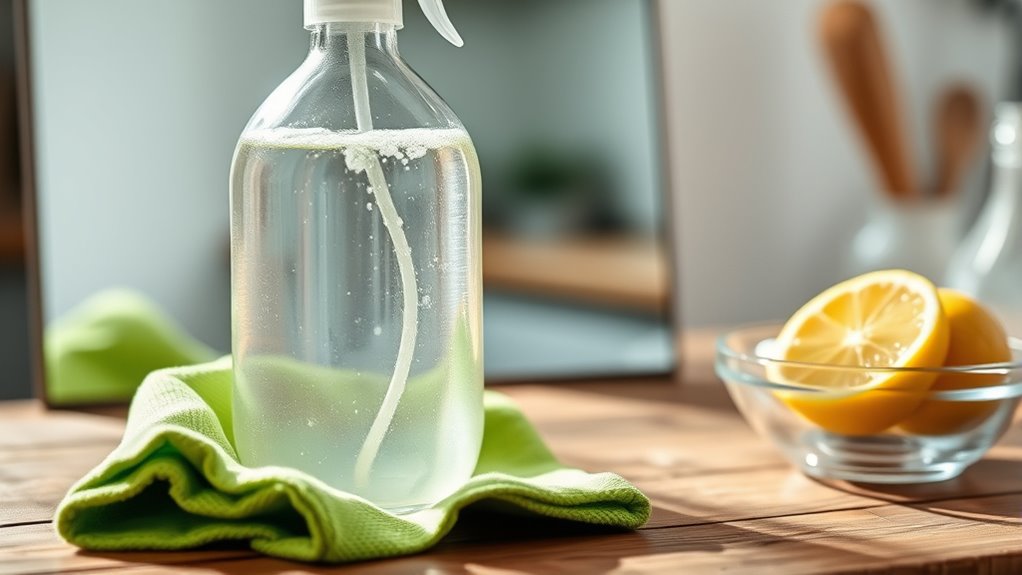
If you want a streak-free shine for your glass and mirrors, a vinegar-based cleaner is an excellent choice. It’s effective for glass cleaning and mirror polishing without harsh chemicals. To make it, mix equal parts white vinegar and water in a spray bottle. For added freshness, add a few drops of essential oil like lemon or lavender. Spray the solution onto the surface and wipe with a microfiber cloth or lint-free paper towel. For best results, use a circular motion to remove smudges and fingerprints. Vinegar’s natural acidity cuts through grime and leaves a clear, streak-free finish. This homemade cleaner is safe, inexpensive, and environmentally friendly, making it perfect for maintaining your glass surfaces with ease and confidence. Regular use of eco-friendly cleaning solutions can also help preserve the longevity of your glass and mirror surfaces over time.
Baking Soda Scrub for Tough Stains
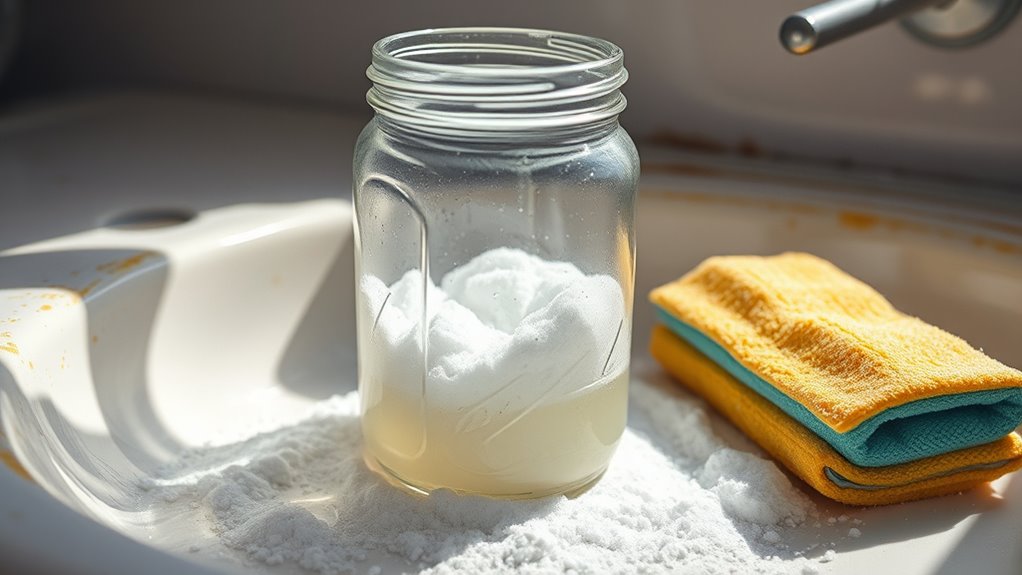
When tough stains stubbornly cling to surfaces, a baking soda scrub can be your most effective weapon. It’s a natural, cost-effective solution that tackles grime and stains with ease. To maximize stain removal techniques, start by wetting the surface and sprinkling baking soda directly on the stain. Then, gently scrub with a damp sponge or brush. For stubborn spots, create a paste with baking soda and water and let it sit for 10-15 minutes before scrubbing. Remember these surface preparation tips: guarantee the area is moist, use gentle pressure, and rinse thoroughly. Visualize the process:
- Applying baking soda directly to stain
- Using a scrub brush or sponge
- Letting a paste sit for enhanced cleaning
- Rinsing for a spotless finish
Additionally, maintaining a positive mindset during cleaning can make the task feel more manageable and even enjoyable.
Natural Furniture Polish Solution
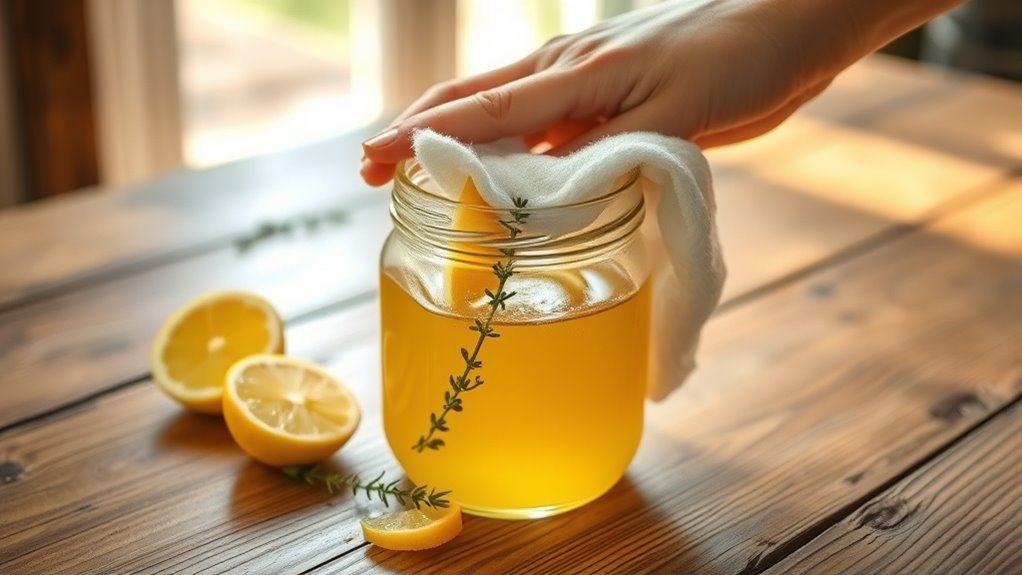
Cleaning and maintaining your furniture naturally is simple with a homemade polish that nourishes and restores wood’s luster. To achieve a beautiful finish, combine equal parts olive oil and lemon juice in a small bottle. Shake well before each use. Apply a few drops to a soft cloth and gently rub it into your furniture, focusing on scratches and dull spots. This natural solution enhances wood finishing by adding a protective layer that brings out the richness of the grain. It’s perfect for furniture restoration, as it deepens the color and smooths the surface without harsh chemicals. Regular use keeps your furniture looking fresh and polished, all while avoiding synthetic cleaners. With this simple DIY polish, your wood pieces will stay beautiful and well-maintained for years. Additionally, using a quality finish can help protect your furniture from future damage and maintain its appearance over time.
Homemade Disinfectant Spray
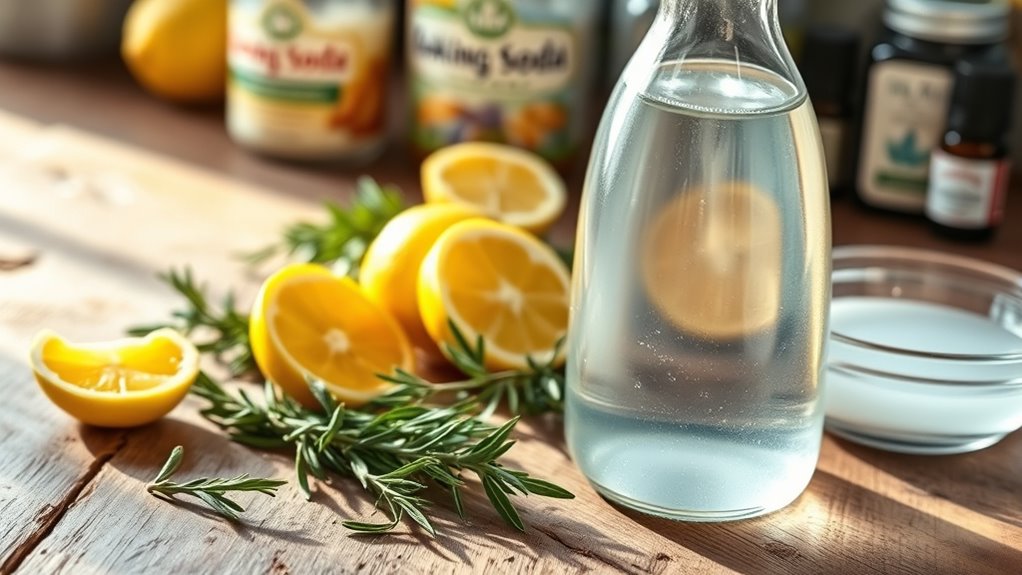
Creating your own disinfectant spray with natural ingredients is simple and effective. You’ll want to focus on proper application techniques to guarantee germs are truly eliminated. Let’s explore the best ingredients and methods for safe, organic disinfection. Using a HEPA filter in your home can further enhance air quality by removing airborne bacteria and allergens, complementing your cleaning efforts.
Natural Ingredients for Disinfection
Natural ingredients like white vinegar, rubbing alcohol, and essential oils are effective and safe options for disinfecting your home. You can enhance your homemade disinfectant spray using herbal infusions or essential oil blends that add natural antibacterial properties and pleasant scents. For example, herbal infusions of thyme or rosemary can boost antimicrobial effects, while essential oils like tea tree, eucalyptus, or lemon deliver powerful disinfectant qualities. To visualize how these ingredients come together, picture:
- A spray bottle filled with a vinegar base infused with herbs
- A mix of essential oils swirling in the spray
- Aromatic herbs steeping in alcohol or vinegar
- A invigorating, natural disinfectant ready to use on surfaces
These natural ingredients provide a safe, effective way to keep your home clean without harsh chemicals. Incorporating filtration systems, such as HEPA filters, into your cleaning routine can further improve indoor air quality by capturing allergens and fine dust.
Proper Spray Application Techniques
When applying your homemade disinfectant spray, proper technique guarantees maximum effectiveness and safety. Your spray technique should focus on thorough coverage of the surface, ensuring it’s evenly coated without over-saturating. Hold the spray bottle about six to eight inches from the surface and use a steady, sweeping motion. The application method involves spraying in a fine mist to avoid waste and ensure even distribution. Avoid overspraying, which can lead to excess runoff and waste of your organic solution. Allow the disinfectant to sit for the recommended contact time before wiping or drying. Consistently applying this spray technique ensures germs are effectively killed, and surfaces are safely disinfected. Mastering the proper application method makes your homemade cleaner both efficient and safe for everyday use. Proper disinfectant application is essential for maintaining a healthy and germ-free environment.
Eco-Friendly Floor Cleaner Mix
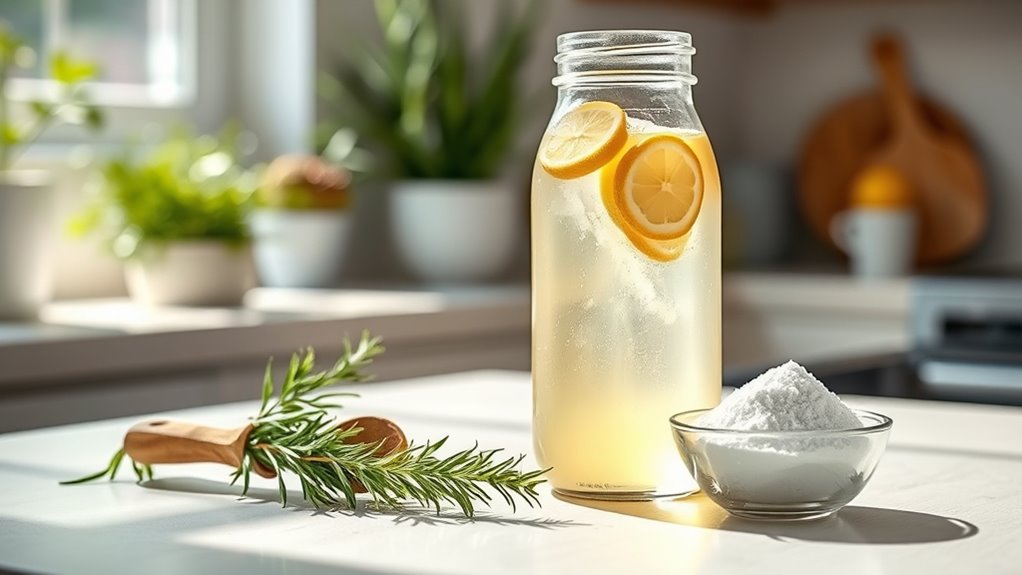
To make an effective eco-friendly floor cleaner at home, start by combining simple, natural ingredients that you probably already have. Skip commercial brands filled with synthetic ingredients and opt for a safer, greener solution. Mix water with a splash of white vinegar to cut through grime. Add a few drops of essential oil for a fresh scent. For extra cleaning power, include a small amount of castile soap. Visualize your mix:
- Warm water and white vinegar
- A few drops of lemon or tea tree essential oil
- Castile soap for suds
- Optional: a teaspoon of baking soda for extra scrub
This blend is free from harsh chemicals, safe for your family, and effective on various flooring types. It’s a simple, budget-friendly way to keep your floors clean naturally. Incorporating glycolic acid in skincare is also beneficial for the skin’s texture and appearance, providing a natural exfoliation that complements your overall health routine.
DIY Toilet Bowl Cleaner With Natural Ingredients
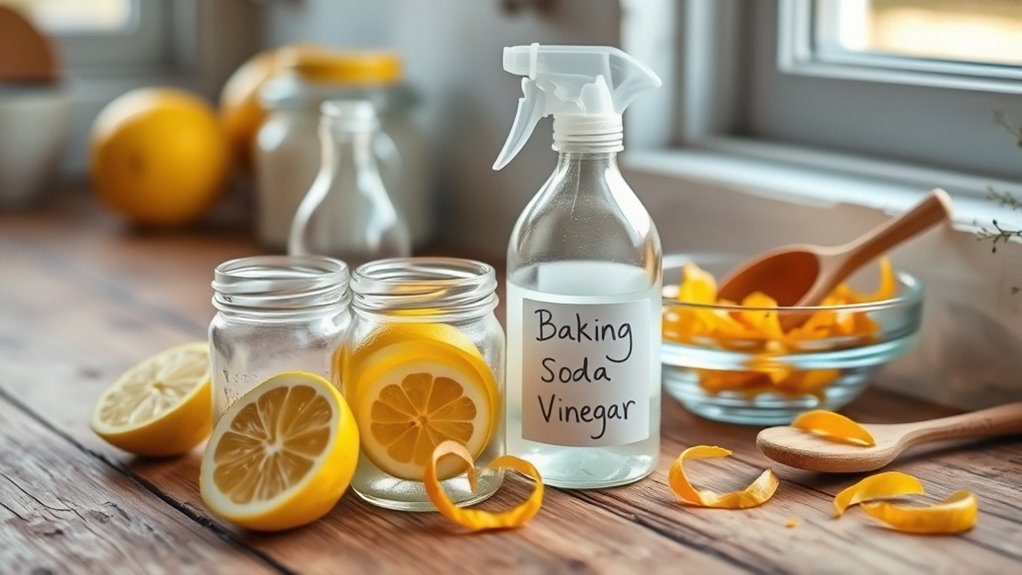
Creating a natural toilet bowl cleaner is simple and effective. You can use ingredients like baking soda and vinegar to tackle stains and odors effortlessly. I’ll guide you through easy preparation steps to keep your toilet fresh and eco-friendly. Incorporating natural cleaning solutions can enhance the effectiveness of your DIY cleaner without relying on harsh chemicals.
Natural Cleaning Agents
Using natural ingredients to clean your toilet bowl is an effective way to maintain a spotless and chemical-free bathroom. Natural cleaning agents harness simple substances that trigger chemical reactions to break down grime without harmful residues. They markedly reduce the environmental impact compared to commercial cleaners, which often contain harsh chemicals. Imagine:
- Baking soda bubbling up as it neutralizes odors and scrubs stains
- Vinegar dissolving mineral deposits with its acidic properties
- Lemon juice providing a fresh scent and natural bleaching power
- Essential oils adding antimicrobial benefits and a pleasant aroma
These ingredients work together to create a powerful, eco-friendly cleaning solution. Not only do they minimize environmental harm, but they also promote a healthier indoor air quality by avoiding toxic fumes. Incorporating these natural agents can also enhance your local culinary scene by reducing chemical runoff that affects regional ecosystems. You can achieve a sparkling toilet with safe, natural agents.
Simple Preparation Steps
Preparing your own natural toilet bowl cleaner is simple and requires just a few common ingredients. First, gather baking soda, white vinegar, and essential oils like tea tree or eucalyptus for added freshness. To avoid cleaning myths, verify proper ingredient sourcing—choose organic or high-quality products whenever possible. Start by sprinkling about half a cup of baking soda into the bowl, then add one cup of white vinegar. Let the mixture fizz and sit for five minutes. Next, add a few drops of your chosen essential oil for a pleasant scent. Use a toilet brush to scrub thoroughly, focusing on stains and buildup. Rinse with water, and your eco-friendly cleaner is ready. This straightforward method guarantees effective cleaning without harsh chemicals, just natural ingredients.
Freshening up With Scented Room Sprays

Adding a scented room spray can instantly refresh your home and create a welcoming atmosphere. To craft your own, choose botanical fragrances like lavender, citrus, or eucalyptus to promote a calming vibe. Use scent layering by combining different essential oils for depth and complexity. When spritzing, imagine:
- A gentle mist filling the air with a fresh, natural aroma
- The subtle scent lingering on fabrics and curtains
- A balanced blend that energizes or relaxes your space
- A personalized touch that reflects your mood and style
Keep the spray light and avoid overdoing it, so the scent remains inviting rather than overpowering. With this simple homemade spray, you easily enhance your home’s ambiance using natural ingredients and thoughtful scent layering techniques.
Storage and Safety Tips for Homemade Cleaners
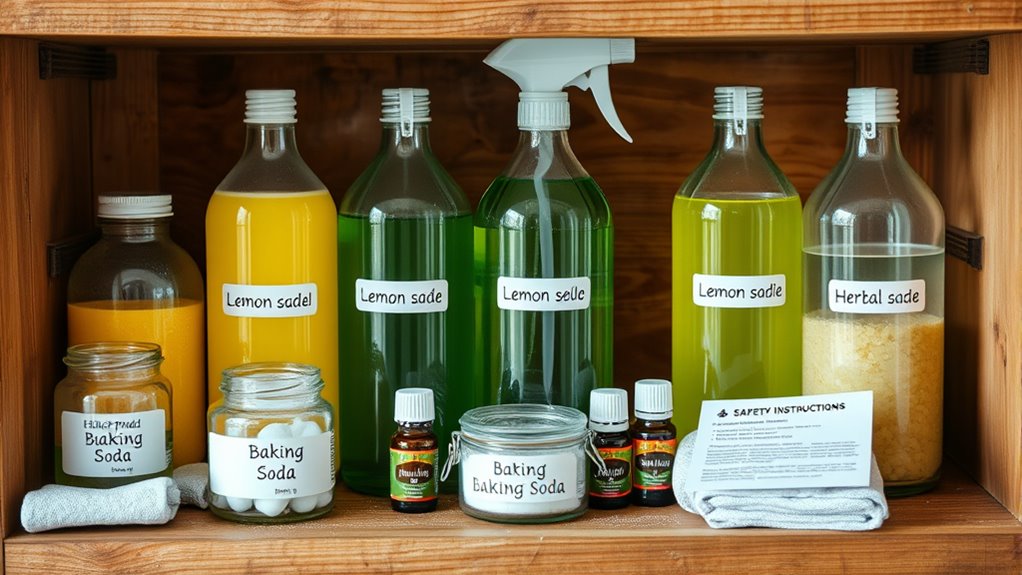
Choosing the right containers guarantees your cleaners stay effective and safe. Store your homemade solutions in clearly labeled, child-proof containers to prevent accidents. Always keep your cleaners in a cool, dry place away from food or personal items to maintain safety.
Proper Container Selection
Selecting the right containers for your homemade cleaners is essential for safety and effectiveness. You want containers that are durable enough to withstand daily use and won’t degrade over time. Proper label design guarantees you can quickly identify each cleaner and avoid mix-ups, especially with different ingredients. Look for containers made from sturdy, chemical-resistant materials like glass or high-quality plastic. Clear containers help you monitor the levels and cleanliness easily. Make sure they have secure, leak-proof lids to prevent spills. Consider containers with wide mouths for easy filling and cleaning. Label each container clearly with the contents and date of preparation. This way, you reduce risks and keep your DIY cleaners effective and safe to use.
Safe Storage Practices
Proper storage of your homemade cleaners is essential to keep them safe and effective over time. Store your solutions in clearly labeled, airtight containers to prevent accidental spills and contamination. Keep them away from direct sunlight and heat sources, which can degrade the ingredients and create chemical hazards. Organize your storage area to ensure that cleaners are separated from food, beverages, and other household items. Consider using shelves or cabinets with childproof locks to prevent accidental access, especially if pets or children are around. Regularly check your storage containers for leaks or signs of deterioration. Proper storage not only maintains the efficacy of your cleaners but also minimizes risks associated with chemical hazards, ensuring your household stays safe.
Frequently Asked Questions
How Long Do Homemade Cleaners Typically Last Before Expiring?
The shelf life of homemade cleaners varies depending on ingredients, but generally, they last from one week to a few months. You should check for changes in smell or appearance to determine if they’re still good. Store your cleaners in airtight containers, away from sunlight, and keep them in a cool, dark place. Proper storage tips help prolong their effectiveness and ensure safety before they expire.
Can I Substitute Ingredients if I Have Allergies?
When considering ingredient substitutions, you can usually make allergy-friendly swaps to keep your cleaner safe. Always check labels and research safe ingredient swaps for your specific allergies, like replacing lemon juice with apple cider vinegar if citrus triggers issues. It’s important to test small amounts first and confirm the new ingredients don’t cause reactions. By choosing safe ingredient swaps, you keep your homemade cleaner effective and allergy-safe.
Are DIY Cleaners Safe for Pets and Children?
Imagine a world where your home sparkles without worries—that’s the promise of DIY cleaners. You should prioritize pet safety and children’s health by choosing ingredients carefully. Always check ingredient substitutions, avoiding harsh chemicals. Use natural options like vinegar, baking soda, and essential oils, but remember some can still be irritating. When in doubt, consult a vet or pediatrician. Your home can be both clean and safe for your loved ones.
How Effective Are Natural Cleaners Compared to Commercial Products?
Natural cleaners can be quite effective, especially for everyday messes, but their chemical effectiveness might fall short on stubborn stains or heavy grime. However, they often have a lower environmental impact, making them a safer choice for your family and the planet. You might need to use a bit more product or effort, but you’ll benefit from a greener, less toxic cleaning routine.
What Should I Do if a Homemade Cleaner Causes Skin Irritation?
If a homemade cleaner causes skin irritation, take immediate action. Rinse your skin thoroughly with water and gently cleanse the area. Apply skin irritation remedies like aloe vera or over-the-counter hydrocortisone cream to soothe discomfort. Avoid scratching and seek allergen testing if symptoms persist. Protect your skin, monitor reactions closely, and prioritize your safety to prevent further irritation. Your health matters, so act promptly and wisely.
Conclusion
Creating your own natural cleaners is like crafting a fresh breeze in your home—simple, satisfying, and good for the environment. With just a few ingredients and a little effort, you can keep your space sparkling without harsh chemicals. Plus, you’ll enjoy knowing exactly what’s inside your cleaners. So, explore these DIY projects and turn your cleaning routine into a revitalizing, eco-friendly adventure that’s as easy as pie. Your home will thank you!
